Conclusion
Final Words
Well, that's a bunch of processor performance alright - pretty cool, huh? The word 'amazing' is the one word that keeps returning while I was testing this platform. First off, this - you will not need a 16 or 12 core processor for your gaming needs, I mean, come on. Get yourself a nice 6 or 8-core processor and by all means please do save yourself a lot of money. But there's always the enthusiast PC DiY builder, and ironically it's a lot of people that can be found in the Guru3D reader-base. An enthusiast experience is what this all about and what it will bring to the table. You get twice the cores for half the money that Intel is asking. And sure, there in the end might be that 5% 1080p game performance difference in-between the two in perhaps Intel's advantage, but still, AMD is king and rules the HEDT market with these prices. So in that mindset it is once again amazing to see how much value you can gain from Threadripper processors, and I do know that 799 or 999 USD is weird to tag with the label 'value', but really... it is. Never, ever has any consumer been able to purchase a 12 or 16-core processor in this price range as that was exclusive to a very expensive server market. For the guys and girls that have pro-workstations and do a lot of video editing, this stuff right here is pure gold. For content creation, again, this is amazing. For the extreme ones that stream, edit, browse and do it all at once, this is, again, amazing. Ergo, this chapter ends where I started it, amazing. And amazing doesn't always have to make sense.
Performance
You have seen the results. Funny story: tests and benchmarks that normally take 5 minutes to finish do that in half or even less the time it usually takes. Many threaded applications will fly in terms of relative performance. And make no mistake, single threaded performance is also really good as Threadripper can boost to 4.0 GHz with an extra 200 MHZ XFR allowance as well. You can clock and thus tweak all cores on this processor to 4 GHz as well. Albeit you do need to wonder if that is fair in terms of extra heat levels and power consumption. But sure, if you wanted to, you could. Make no mistake, you do not need a 16-core processor, I have stated it many times already, I feel that we all need to move to 6 and 8-core processors as these simply offer a snappier and faster PC eco system with all the things we do simultaneously on a PC these days. But in the long term a platform like this might last you many, MANY years. You have the performance, the threads and let's not forget the connectivity with the many PCIe Gen 3.0 lanes available.
The Experience
I am also happy to report that, with the launch BIOS and motherboard we really did not run into any significant enough issues. The memory compatibility and stability was truly good. If you pick your memory right, you will not have any issues as the initial Ryzen releases have already removed the launch issues. In the BIOS simply enable the XMP SPD profile and you'll boot straight into Windows with your new timings and frequency. I've mentioned it a couple of times already, but please read up in this article for some good memory recommendations. These memories work on Ryzen, and will work just as well on Threadripper.
A quick video recording of Battlefield 1 running on a GeForce GTX 1080 @ 2560x1440 with Ryzen Threadripper 1920X 12c/24t to demonstrate the thread distribution, allocation and utilization.
Game performance then, it's fine. Yes, you'll be able to perhaps gain a bit more performance at 1080p in a CPU bound situation from a faster clocked Intel counter-part. How important that is to you is totally up-to you. My advice, take the money you save on the AMD platform and invest that in a faster GPU. That's what I call a double whammy. Think about it. Stability then, no problems whatsoever. The PC boots at XMP speeds into Windows instantly, we didn't have a single crash or weird instability whatsoever.
The Memory
We mentioned DDR4 memory a couple of times already; the new AGESA 1006 based BIOSes have improved a lot, Threadripper is getting AGESA 2006 at launch, the same stuff. 3200 MHz is a non-issue with the right memory, we recommend 2933 MHz or better when you build a gaming rig. Obviously with quad-channel you could go a little slower as you gain more bandwidth. All previous AGESA 1006 and newer firmware approved memories as we have tested should be fine to use. It is however a new platform and chipset, hence please do give AMD and their motherboard partners a little time to iron out any inevitable bugs and launch issues (but we haven't ran into anything significant enough really).
The Power
With this processor now fabbed at 14 nm FinFET the TDP sticks to roughly 180 Watts. A full PC at idle will sit in the 95 Watt range with a dedicated graphics card installed (GeForce GTX 1080 / 16 GB memory / SSD and the motherboard). When we stressed the processor with a Prime 1024M run we reached roughly 250 Watts, that's low enough for what it needs to be. Overall though, this is impressive to see with sixteen CPU cores, especially compared to what we have seen from Intel more recently. When we game we hover at ~320 Watts which is higher than we are used to, but that's the 2nd CPU die, and obviously that factor is dependant on the type of graphics card you use of course as well as how many CPU cores the game utilizes. So yeah, these are a notch higher, but overall good enough values with this mega-core product.
The Negatives
As you probably have heard, Intel made a bit of a sting in one of their media processor slides, calling Threadripper glued together. The reality is, there is some merit to that statement. In the end there are two dies active under that big heatspreader. That engineering choice does come with consequences and, in the end, compromises. First and foremost is the idle power consumption. You have two 8-core dies, obviously one of them isn't mysteriously shutting itself down when in idle. As a result your idle power consumption nearly doubles and sits just under or around a hundred watts. In the year 2017, really you want to see, say, 50'ish Watts there. Intel on their 10-core parts (with the newest firmware) sit a good 25 Watts lower in the 70 Watt range, not great either. So yes, I am not happy about idle power consumption. Average and peak utilization power consumption is fine.
The UMA (distributed) / NUMA (local) memory mode toggles are just embarrassing really. I mean, why oh why is there always some sort of compromise to be made with AMD memory solutions? With Ryzen it was the need for faster clocked memory, not for the clocks but the Infinity Fabric connecting it all uses the same memory multiplier. For Threadripper, really, you don't want to switch in-between less or more threaded modes, the sum of all parts and performance there should be equal in all circumstances.
I also need to mention gaming. Do not expect your Threadripper setup to run faster due to the many cores or quad-channel memory, it is the same Ryzen architecture and you will need to invest in expensive high-frequency memory to get that all up-to snuff. I do not consider the Threadripper platform to be an ultimate gamers platform whatsoever, not even all the PCI-Express Gen 3 channels will make that much of a difference. It is however as good as regular Ryzen 5 and 7. So if you are after more bang for buck, your value is to be found in regular Ryzen setups.
Last but not least, tweaking remains to be a bit of a conundrum. You can achieve an all-core tweak to 4.0 GHz. Intel goes higher on their clocks and often can reach 4.5 to 5 GHz. That's where some residual games performance is found in CPU bound situations. It also would have been nice to see a per core or even per CCX (per 4 cores) tweak. Say, four cores at 4200 MHz, four at 4000 MHz and the rest at 3700 MHz. That way you can balance heat and energy consumption better while getting more performance in your main and prioritized threads. The fact that you can clock 16 cores to 4.0 GHz stable at fairly low voltage however is pretty amazing stuff. And that's where we land in the following paragraph.
The Tweak
Anything Ryzen architecture based goes to roughly a max of 4 GHz, but will also end there with an all-core tweak. This is the same for Threadripper. Apply a 40x multiplier, use a voltage offset that gets you close or just at 1.35 volts and you should be able to rock and roll. Now, 4.1 and even maybe 4.2 GHz can be achieved, but requires voltage in the 1.40 volt ranges. And to be brutally honest with 12 or 16 cores, that's not where you want to be for reasons of heat and energy consumption. Be advised though, tweaking creates more heat and thus make sure you have enough cooling. We surely recommend some form of liquid cooling. On the cooling-block / processor surface area coverage we said enough, it's not an issue. None whatsoever. Obviously, tweaking will also increase your power consumption (when the PC is stressed), please do keep that in mind.
The conclusion
The hype is now real. AMD delivers what they promised with Threadripper. With a processor choice of up-to sixteen cores and thirty-two threads combined with acceptable heat and power consumption levels the sky is the limit, and that's what you get for under a thousand USD. Now honestly, I would not label the platform as perfect, but I would label it really good as, hey, this platform is such a crazy multi-threading beast! I am also not going to state that everybody should get a PC like this either, as realistically who really needs 12 or 16 cores, right? And sure, in that respect I also have to state that this is not a gamer's platform in the sense that it offers value for money (specific to gaming though). The UMA/NUMA configurations are silly yet I can live with them. And also quad-channel memory does not bring in additional performance gaming wise (aside from Tomb Raider), so really you are better off with, say, a 4.0 GHz tweaked Ryzen 7 1700 or Ryzen 5 1600 as a gamer. You could argue and throw multi-GPU at two x16 configured lanes at me, but realistically over two x8 lanes gen 3.0 you're not going to see much difference there either as the PCI bus is not data flooded. But it is nice to have all that PCIe bandwidth for sure. That said, X399 has a lot to offer, certainly more than what Intel offers with X299.
The people that do benefit from all this crazy core madness and will adore Threadripper are content creators: video-editing, 3D content rendered on the CPU, megatask-o-maniacs that play games, record and stream at the same time (albeit an 8-core would probably be sufficient here as well). I can also see many benefits for developers and programmers who like to run many virtualized OSes and so on. So the ones that do have a need for many (mega) threads and processors are real enthusiasts yet rather specifically maybe, the professional crowd. But sure, they will justifiably go wild about this release alright.
At twelve or sixteen cores you also cannot beat the value that Threadripper brings to the table compared to team blue. If you decide to invest in one, it's going to last you so many years. And with software slowly getting more and more threaded, it might even be a wise investment. That said, purely for gaming and everyday usage this investment really doesn't make much sense. But let me throw another mindfrack at you; does it have to make sense? It's a question I have asked myself a number of times while writing this review. See, this is x-factor stuff, it's for the same reason that you spend mo' money on a factory tweaked graphics over a reference one. The same people that buy the most expensive graphics cards. My point, it doesn't always have to make sense.
Most, and certainly all important variables are good including price, performance and the ability to tweak all the cores on the processor. The X399 motherboards are going to sit in the same price range as the X299 boards from Intel. They'll start at the 300 USD marker and work their way upwards from there onwards, and there will be a lot to choose from alright. Tweaking wise, I am sure that all Threadripper processors will reach 4 GHz on all cores, really the chance and likelyhood they can do that is very probable, but even 100 MHz higher can be problematic to achieve with that all-core overclock. Regardless, with 64-PCIe-Express gen 3.0 lanes, quad-channel memory and the biggest smile on your face in years I do know this, you'll love your Threadripper PC. This 16-core processor, at under a thousand bucks simply is a top pick (for those that need it).
ATH +++
- Hilbert out
- Sign up to receive a notice when we publish a new article
- Or go back to Guru3D's front page.
“A mind needs books as a sword needs a whetstone, if it is to keep its edge.”



